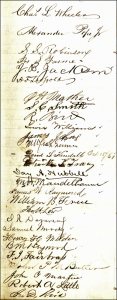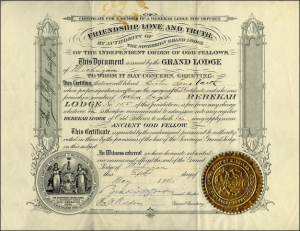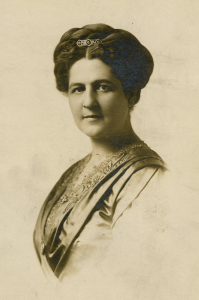![“First regular communication of Quincy Lodge U.D. [under dispensation] F. & A. M. [Free and Accepted Masons] held at Lodge room in Village of Hancock, June 6th A.D. 1861 A.L. [Anno Lucis: ‘In the Year of Light’] 586. Present, Charles L. Wheeler W.M. [Worshipful Master], Jacob Hougton Jr. S.W. [Senior Warden], Alexander Pope Jr. J.W. [Junior Warden], J.A. Close S.D. [Senior Deacon] pro tem, J.P.M. Butler J.D. [Junior Deacon] pro tem, J.A. Hubbell Secty pro tem, S.S. Robinson Treasr pro tem, A.F. Leopold Tyler pro tem, & Brethern Lodge opened in due form in 3rd degree of Masonry The worshipful Master then read the dispensation granted by the G.M. [Grand Master] of the State of Michigan On Motion a committee of Three consisting of the W.M., S.W., & J.W. was appointed to draft the By Laws for the government of the lodge and report at next regular communication. On Motion Bro. Berd was allowed to occupy the preparation room till first of Sept. 1861. The W.M. appointed Tuesdays & Friday Evenings of each week as stated communications for instruction. On Motion the Lodge closed in harmony. Jay A. Hubbell Secty -pro tem-”](https://blogs.mtu.edu/archives/files/2017/09/blog1.png)
Jay A. Hubbell Secty
-pro tem-”
The Freemasons, the Odd Fellows, the Knights of Pythias…secret societies. Many people find them fascinating, but many may also have a misunderstanding of exactly what these secret societies are or what they do. Most “secret societies” are more mundanely referred to as fraternal organizations. Organizations such as these may have a variety of purposes, including social or charitable goals, or insuring the financial well being of members or their families in case of accidents or hard times or any combination of these or related goals.

Since very early on in the history of the Copper Country these organizations have had a presence. Thanks in large part to their portrayal in popular culture, the most well known fraternal organization is likely the Freemasons. And, indeed, they were one of the first secret societies in the Keweenaw. The first chapter of Free and Accepted Masons, the Quincy Lodge No. 135, was established here in the summer of 1861, just after the beginning of the Civil War. That’s less than 20 years after the Treaty of La Pointe ceded the land in the Keweenaw Peninsula to the United States, 15 years after the Quincy Mining Company was established, and just 2 years after the city of Hancock was founded.
Some of the Quincy Lodge’s founding members included some names that may sound familiar. The first “Senior Warden” (second in command) of the Lodge was Jacob Houghton Jr., brother to State Geologist Douglass Houghton (Douglass had passed away in 1845). Jacob accompanied his brother on his famous geological survey, and contributed to the report that was responsible for the copper rush in the Keweenaw. The first Secretary (pro tem) was Jay A. Hubbell. Both the town of Hubbell, and Michigan Tech’s now demolished Hubbell Hall were named for the Mason. At the time Hubbell was a Houghton County attorney, and would later be a U.S. Congressman, State Senator, and district court judge. He was instrumental in helping to establish the Michigan School of Mines, which later became Michigan Technological University.

Members of the Freemasons were very often pillars of the community, and membership in such fraternal organizations could be used to make useful political and social connections, as well as to increase one’s social standing. The Michigan Tech Archives has an extensive collection on the Masons in the Copper Country. MS-035, The Copper Country Masonic Lodge Collection consists of 66 boxes related to the Quincy (later Copper Country) Lodge No. 135, Houghton Lodge No. 218, Keweenaw Lodge No. 242, Calumet Lodge No. 271, John Duncan Lodge No. 373 in addition to various other associated groups such as the Order of Molay, the Michigan Grand Lodge, the Royal Arch Masons, and material related to Masonic buildings such as the Houghton Masonic Temple and the Union Building in Calumet (now the headquarters of Keweenaw National Historical Park).

While most people are familiar with the Freemasons, some of the other fraternal organizations operating in the Copper Country may be a little more unfamiliar. The Independent Order of Odd Fellows (IOOF), for example, were very popular, and in fact, a larger organization than the Masons for much of their existence.The Independent Order of Odd Fellows were formed in Baltimore in 1842, an offshoot of the British Oddfellows organization. The IOOF dedicates itself to charity, it’s purpose to “visit the sick, relieve the distressed, bury the dead and educate the orphan”. Of course, the Odd Fellows also used the organization, much like the Freemasons, for fellowship and socialization.

Despite the name, however, “fraternal” organizations weren’t just limited to men. The Odd Fellows became the first of its kind in the United States to admit women in 1851 when the Daughters of Rebekah were created as the Odd Fellows women’s auxiliary organization (both groups would eventually admit both men and women). The archives has a wide variety of records related to the Odd Fellows, including from the Hecla Lodge 90, the Mystic Lodge 109, the Holly Rebekah Lodge, and the Ivy Rebekah Lodge, and many items such as photographs spread throughout our collections.
By 1890 the Knights of Pythias also had a presence in the Copper Country, despite the organization not even existing until the end of the Civil War, a quarter century earlier. The Knights were similar in organization and purpose to the Masons and Odd Fellows, but while those groups were brought over from Europe, the Knights were originally founded in the U.S. The “F.C.B.” initials you can see in the emblem on the cover of the by-laws stands for the Pythian motto: Friendship, Charity, Benevolence.

The Daughters of the Eternal City were an Italian/Italian American women’s mutual benefit society located in Calumet, but in addition to providing aid to members in need, the Daughters partook in their own share of secret society traditions. While I don’t speak Italian, I am an avid Google Translator. With a little help from Google, my colleague Allison, and a bit of judicious interpretation, part of the ritual described in their rulebook includes this tidbit regarding latecomers: “The sisters who are late, when the meeting is already open, will knock at the door with one distinct stroke and three consecutive strokes. The doorkeeper opens the door saying ‘Rome’. The sister outside will answer ‘Eternal’.” You can’t have a secret society meeting without a secret password.
As you can see, the Copper Country has a long and rich relationship with fraternal organizations, and the Michigan Tech Archives contains a variety of records related to those organizations. Unfortunately this blog post has barely scratched the surface of the wealth of information that could be mined from our various collections. Who knows, maybe this blog post may inspire some current or future historian to enlighten about what the records of these “secret” societies can tell us.